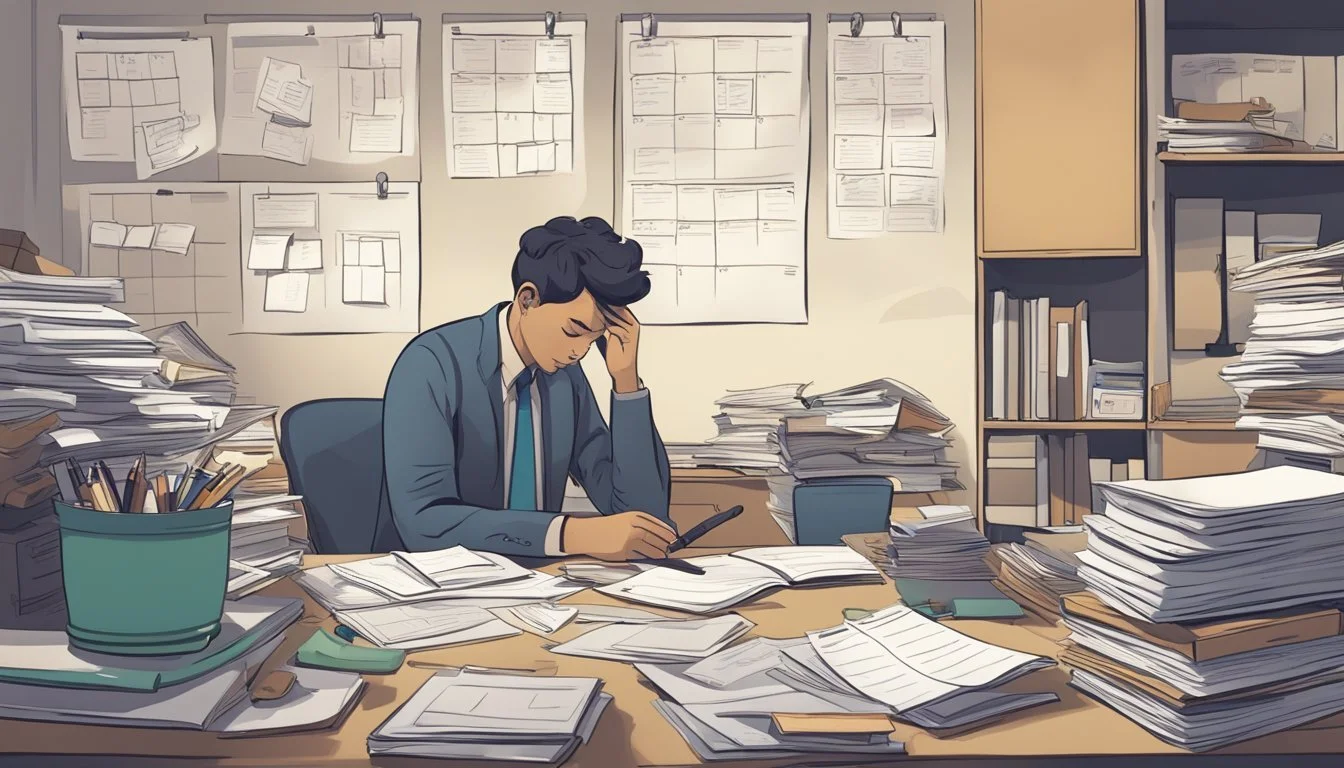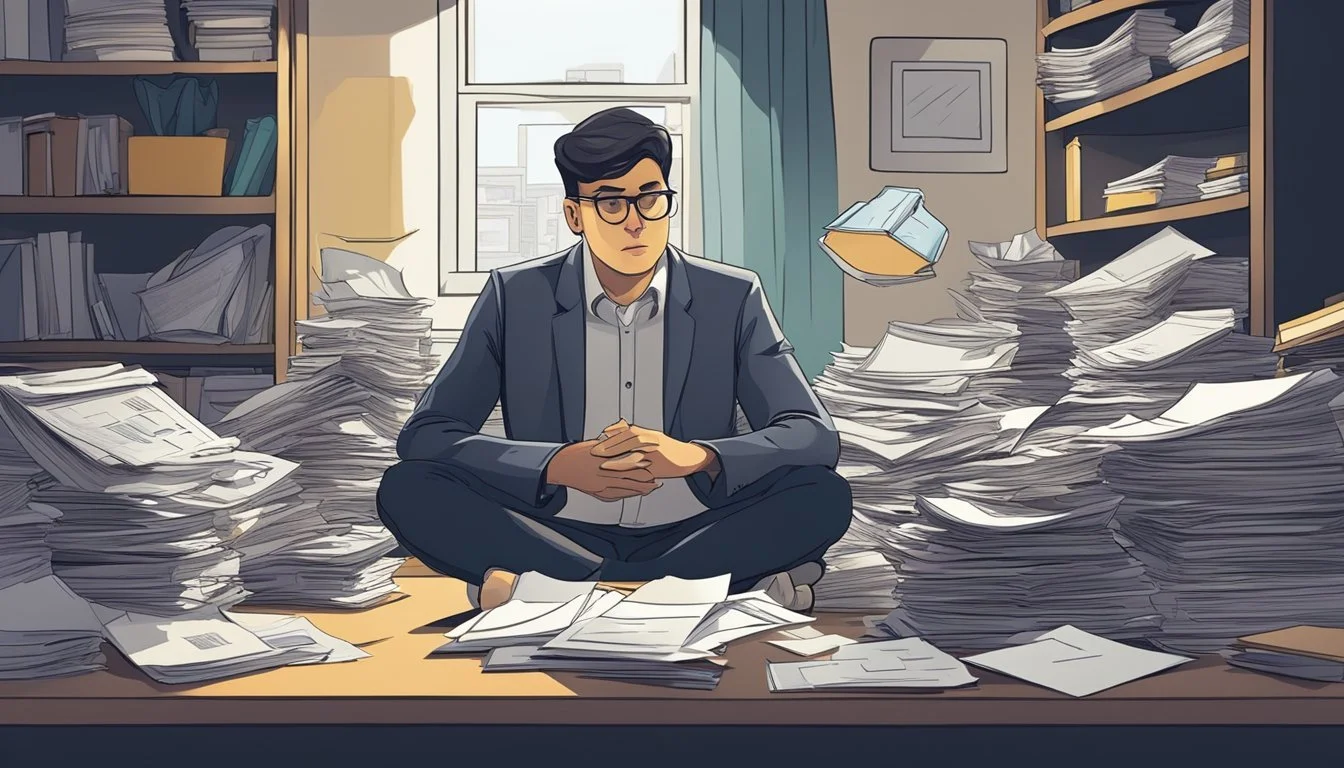10 Strategies for Coping with Depression-Induced Decision Paralysis
Overcoming Mental Roadblocks
Depression can profoundly impact decision-making abilities, leading to a state of mental paralysis. This condition often leaves individuals feeling stuck and unable to take action, even on seemingly simple choices. Recognizing and addressing depression-induced decision paralysis is crucial for improving overall well-being and daily functioning.
Effective strategies exist to help people overcome this challenging aspect of depression. By implementing specific techniques and approaches, individuals can gradually regain their decision-making confidence and break free from the cycle of inaction. These methods aim to reduce anxiety, boost motivation, and provide a structured framework for tackling decisions both big and small.
1) Practice Mindfulness Meditation
Mindfulness meditation is a powerful tool for managing depression-induced decision paralysis. This practice involves focusing attention on the present moment without judgment.
Regular mindfulness meditation can help individuals become more aware of their thoughts and emotions. By observing these mental states without getting caught up in them, people can gain clarity and reduce overwhelming feelings.
Mindfulness techniques can improve focus and concentration, which are often impaired during depressive episodes. This enhanced mental clarity can make decision-making less daunting.
Research has shown that mindfulness-based interventions can effectively reduce symptoms of depression and anxiety. These practices may help break the cycle of rumination that often contributes to decision paralysis.
To begin, individuals can start with short daily sessions of 5-10 minutes. Simple breathing exercises or body scans are excellent starting points for developing a mindfulness practice.
As comfort with the practice grows, people can gradually increase the duration of their sessions. Consistency is key in reaping the benefits of mindfulness meditation for managing depression and decision-making difficulties.
2) Create a Daily Routine
Establishing a daily routine can provide structure and stability for those struggling with depression-induced decision paralysis. A consistent schedule helps reduce the mental load of making choices throughout the day.
Start by setting a regular wake-up time and bedtime. This helps regulate the body's natural sleep-wake cycle, which is often disrupted by depression.
Include basic self-care tasks in the routine, such as eating meals at set times, taking medications, and personal hygiene activities. These small accomplishments can build momentum and boost self-esteem.
Incorporate physical activity into the daily schedule. Even a short walk or gentle stretching can improve mood and energy levels.
Plan specific times for work or other responsibilities. Breaking larger tasks into smaller, manageable steps can make them feel less overwhelming.
Allow for moments of relaxation and enjoyment in the routine. This might include reading, listening to music, or engaging in a hobby.
Remember that creating a routine is a gradual process. Start with a few key activities and gradually add more as it becomes comfortable.
3) Break Down Tasks into Smaller Steps
Depression-induced decision paralysis can make even simple tasks feel overwhelming. Breaking down larger tasks into smaller, more manageable steps can help combat this feeling.
Start by identifying a task that needs to be completed. Then, divide it into several smaller subtasks. Each subtask should be specific and achievable within a short time frame.
For example, instead of "clean the house," break it down into "wash dishes," "vacuum living room," and "do laundry." This approach makes the overall task less daunting and provides clear, actionable steps.
Create a checklist or to-do list with these smaller steps. As each subtask is completed, cross it off the list. This visual progress can provide a sense of accomplishment and motivation to continue.
Remember that it's okay to tackle just one or two subtasks per day. The goal is to make steady progress, not to overwhelm oneself. Celebrate small victories along the way to reinforce positive feelings and build momentum.
By breaking down tasks, individuals can regain a sense of control and reduce the anxiety associated with decision paralysis. This strategy helps make progress more manageable and less intimidating.
4) Try Cognitive Behavioral Techniques
Cognitive Behavioral Therapy (CBT) offers effective strategies for managing depression-induced decision paralysis. CBT focuses on identifying and changing negative thought patterns and behaviors that contribute to depression and inaction.
One key technique is cognitive restructuring. This involves recognizing distorted thoughts and replacing them with more balanced, realistic ones. For example, instead of thinking "I'll never make the right choice," one might reframe it as "I can make a decision based on the information I have."
Behavioral activation is another useful CBT approach. It encourages engaging in activities that bring a sense of accomplishment or pleasure, even when motivation is low. This can help break the cycle of inaction and improve mood.
Problem-solving techniques taught in CBT can also be valuable. These involve breaking down complex decisions into smaller, more manageable steps. This approach can make the decision-making process feel less overwhelming.
CBT also emphasizes developing coping skills. These may include relaxation techniques, mindfulness practices, or stress management strategies. Such skills can help reduce anxiety associated with decision-making.
Role-playing is another CBT technique that can be helpful. It allows individuals to practice making decisions in a safe, supportive environment before facing real-life situations.
5) Exercise Regularly
Regular physical activity can be a powerful tool for combating depression-induced decision paralysis. Exercise releases endorphins, the body's natural mood boosters, which can help alleviate symptoms of depression and anxiety.
Even moderate exercise, such as a 30-minute walk, can make a significant difference. It provides a structured activity that requires minimal decision-making, offering a respite from the mental strain of constant choices.
Engaging in exercise also improves cognitive function and increases energy levels. This enhanced mental clarity can help individuals approach decisions with renewed focus and reduced feelings of overwhelm.
Consistency is key when incorporating exercise into a routine. Starting with small, achievable goals can build momentum and confidence. As exercise becomes a habit, it can serve as a reliable coping mechanism during periods of decision paralysis.
Group exercise classes or team sports can provide additional benefits. They offer social interaction and support, which can be valuable for those struggling with depression and decision-making difficulties.
6) Seek Professional Help
Depression-induced decision paralysis can be overwhelming to tackle alone. Mental health professionals possess the expertise to accurately diagnose and effectively manage depression.
Psychiatrists, psychologists, and therapists offer specialized treatments tailored to individual needs. They can provide cognitive-behavioral therapy, medication management, or a combination of approaches.
These professionals create a safe space for individuals to express their thoughts and feelings without judgment. They equip patients with coping strategies and tools to navigate decision-making challenges.
Seeking help is a sign of strength, not weakness. It demonstrates a commitment to personal well-being and growth. Professional support can be crucial in breaking the cycle of depression and paralysis.
Many healthcare providers now offer teletherapy options, making it easier to access care from home. This can be particularly helpful for those struggling with motivation or energy to attend in-person appointments.
Remember, recovery is a journey, and professional guidance can provide invaluable support along the way. Taking the step to reach out for help is a significant move towards managing depression and regaining decision-making abilities.
7) Set Realistic Goals
Setting realistic goals can be an effective strategy for overcoming depression-induced decision paralysis. When faced with overwhelming choices, breaking tasks into smaller, achievable objectives helps reduce anxiety and increases motivation.
Start by identifying one or two areas where progress is desired. Choose goals that are specific, measurable, and time-bound. For example, "I will take a 10-minute walk three times this week" is more actionable than a vague goal like "exercise more."
Prioritize goals that align with personal values and interests. This increases the likelihood of follow-through and provides a sense of purpose. Remember that small steps forward are valuable and can build momentum.
Be flexible and adjust goals as needed. Depression symptoms may fluctuate, so it's important to reassess and modify objectives regularly. Celebrate small victories along the way to reinforce positive behaviors and boost confidence.
Consider using a goal-tracking app or journal to monitor progress. Visual representations of accomplishments can serve as motivation during challenging periods. Sharing goals with a trusted friend or therapist can provide accountability and support.
8) Use Time Management Apps
Time management apps can be valuable tools for individuals struggling with depression-induced decision paralysis. These digital assistants help break tasks into manageable chunks and set clear deadlines.
Popular apps like Todoist, Trello, or Asana allow users to create lists, set reminders, and track progress. This structure can reduce the mental burden of decision-making and provide a clear path forward.
Some apps use the Pomodoro Technique, which breaks work into focused 25-minute intervals followed by short breaks. This method can help combat procrastination and maintain momentum.
Calendar apps like Google Calendar or Apple Calendar can be used to schedule specific times for decision-making tasks. This approach prevents endless deliberation by setting definite time limits.
Many time management apps offer collaboration features, allowing users to share tasks with friends, family, or therapists. This support system can provide accountability and encouragement during difficult periods.
By leveraging these digital tools, individuals can create a more organized approach to decision-making, potentially alleviating some of the paralysis associated with depression.
9) Engage in Creative Hobbies
Creative hobbies can be a powerful tool for managing depression-induced decision paralysis. These activities provide a productive outlet for self-expression and can help shift focus away from overwhelming choices.
Painting, drawing, or coloring can be particularly beneficial. These visual arts allow individuals to express emotions without words and create something tangible, fostering a sense of accomplishment.
Writing, such as journaling or poetry, offers a way to process thoughts and feelings. This can help clarify decision-making processes and reduce mental clutter that contributes to paralysis.
Crafting, like knitting or pottery, engages both the mind and hands. The repetitive nature of these activities can be meditative, promoting relaxation and reducing anxiety associated with decision-making.
Music-related hobbies, such as playing an instrument or singing, can also be therapeutic. These activities stimulate different parts of the brain and provide a sense of progress as skills improve.
Engaging in creative hobbies regularly can build confidence and improve overall mood. This increased self-assurance may translate into better decision-making abilities in other areas of life.
10) Limit Exposure to Stimulants
While stimulants can provide a temporary boost in energy and focus, they may exacerbate depression and decision-making difficulties in the long run. Caffeine, nicotine, and other stimulants can disrupt sleep patterns and increase anxiety levels.
Reducing stimulant intake can help stabilize mood and improve overall cognitive function. This includes cutting back on coffee, energy drinks, and sugary snacks that provide quick but unsustainable energy spikes.
Instead, individuals can opt for herbal teas or decaffeinated beverages. Gradually decreasing stimulant consumption allows the body to adjust and may lead to more consistent energy levels throughout the day.
It's important to note that some medications for depression may interact negatively with stimulants. Consulting a healthcare provider about potential interactions is crucial for those on antidepressants or other psychiatric medications.
By limiting stimulant exposure, individuals may experience improved sleep quality, reduced anxiety, and a more stable foundation for decision-making. This strategy can contribute to better overall mental health and coping abilities.
Understanding Depression-Induced Decision Paralysis
Depression can significantly impair a person's ability to make decisions, leading to a state of mental paralysis. This cognitive dysfunction affects daily functioning and quality of life.
What Is Decision Paralysis?
Decision paralysis occurs when an individual struggles to make choices, even for minor tasks. It involves excessive overthinking, fear of negative outcomes, and an inability to commit to a course of action. People experiencing this may feel stuck, anxious, and overwhelmed by options.
Decision paralysis can manifest in various ways:
Procrastination
Constant second-guessing
Seeking excessive reassurance
Avoiding decisions altogether
The severity can range from mild indecisiveness to complete inaction in important life areas. This state of mental gridlock often leads to missed opportunities and increased stress.
The Impact of Depression on Decision-Making
Depression significantly alters cognitive processes, impairing decision-making abilities. It affects motivation, concentration, and self-esteem, making choices feel insurmountable.
Key effects of depression on decision-making include:
Negative bias in evaluating options
Difficulty weighing pros and cons
Reduced confidence in one's judgment
Impaired ability to envision future outcomes
These cognitive distortions can lead to a cycle of inaction and self-doubt. Depressed individuals may fixate on potential negative outcomes, further fueling their paralysis.
Depression also depletes mental energy, making even small decisions feel exhausting. This fatigue compounds the challenge of breaking free from decision paralysis.
The Science Behind Decision Paralysis
Decision paralysis stems from complex interactions in the brain and mind. Neurobiology and psychology both play key roles in this phenomenon that can significantly impact daily functioning.
Neurobiological Factors
The prefrontal cortex, responsible for executive functions like decision-making, shows altered activity during decision paralysis. Brain imaging studies reveal increased activation in the anterior cingulate cortex, associated with conflict monitoring. This heightened activity can lead to a mental "gridlock" as the brain struggles to resolve competing options.
Neurotransmitters also influence decision-making processes. Dopamine, linked to reward and motivation, may be dysregulated in individuals experiencing chronic indecisiveness. Serotonin imbalances, common in depression, can further impair decision-making abilities.
Stress hormones like cortisol affect the brain's decision-making centers. Prolonged stress can lead to structural changes in the hippocampus and amygdala, impacting memory and emotional processing crucial for effective decision-making.
Psychological Mechanisms
Cognitive biases play a significant role in decision paralysis. The paradox of choice suggests that an abundance of options can lead to anxiety and indecision. This phenomenon often manifests as analysis paralysis, where overthinking hinders action.
Fear of regret is a powerful psychological factor. Individuals may avoid making decisions to prevent potential disappointment or negative outcomes. This avoidance can become a self-reinforcing cycle, intensifying feelings of paralysis.
Perfectionism contributes to decision paralysis by setting unrealistic standards. The pursuit of an ideal choice can lead to excessive rumination and delay. Low self-esteem may also exacerbate indecisiveness, as individuals doubt their ability to make good choices.
Learned helplessness, often associated with depression, can reinforce decision paralysis. Past experiences of perceived failure or lack of control may lead to a belief that one's choices don't matter, further inhibiting decision-making processes.
Cognitive-Behavioral Strategies
Cognitive-behavioral techniques offer powerful tools for managing depression-induced decision paralysis. These evidence-based approaches target negative thought patterns and behaviors that contribute to indecisiveness.
Mindfulness Techniques
Mindfulness practices help individuals become more aware of their thoughts and emotions without judgment. This increased self-awareness can reduce anxiety around decision-making.
One effective technique is the body scan. It involves focusing attention on different parts of the body, noticing physical sensations without trying to change them. This practice can help ground someone feeling overwhelmed by choices.
Another useful approach is mindful breathing. Taking slow, deliberate breaths while focusing on the sensations of inhaling and exhaling can calm racing thoughts.
Mindfulness meditation, even for short periods, can improve concentration and reduce rumination. This clearer mental state often leads to more confident decision-making.
Cognitive Restructuring
Cognitive restructuring aims to identify and challenge negative thought patterns that fuel indecision. This process helps reframe unhelpful beliefs into more balanced, realistic perspectives.
A key technique is the thought record. Users write down troubling thoughts, identify cognitive distortions, and develop alternative, more balanced viewpoints. For example:
Negative Thought Cognitive Distortion Balanced Thought "I'll make the wrong choice and ruin everything." Catastrophizing "While there may be consequences, one decision is unlikely to ruin everything. I can learn from any outcome."
The "evidence for/against" technique involves listing proof supporting and contradicting a negative belief. This balanced approach often reveals that fears are exaggerated.
Positive self-talk can counteract self-doubt. Developing and repeating affirming statements like "I am capable of making good decisions" can boost confidence over time.








